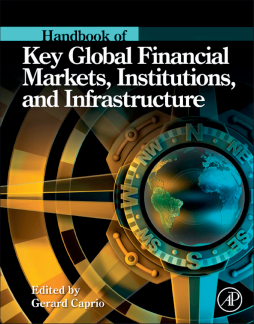
BOOK
Handbook of Key Global Financial Markets, Institutions, and Infrastructure
(2012)
Additional Information
Book Details
Abstract
Understanding twenty-first century global financial integration requires a two-part background. The Handbook of Key Global Financial Markets, Institutions, and Infrastructure begins its description of how we created a financially-intergrated world by first examining the history of financial globalization, from Roman practices and Ottoman finance to Chinese standards, the beginnings of corporate practices, and the advent of efforts to safeguard financial stability. It then describes the architecture itself by analyzing its parts, such as markets, institutions, and infrastructure. The contributions of sovereign funds, auditing regulation, loan markets, property rights, compensation practices, Islamic finance, and others to the global architecture are closely examined. For those seeking substantial, authoritative descriptions and summaries, this volume will replace books, journals, and other information sources with a single, easy-to-use reference work.
- Substantial articles by top scholars sets this volume apart from other information sources
- Diverse international perspectives result in new opportunities for analysis and research
- Rapidly developing subjects will interest readers well into the future
"In times of turmoil, people seek understanding and composure by looking to the past for guidance. This collection of papers provides an excellent reference in our troubled financial times for investors, analysts, and policy makers. As the first comprehensive attempt to document the world’s monetary past, the volume makes a terrific supplement for courses in financial history."--Richard Steckel, The Ohio State University
"The Handbook of Key Global Financial Markets, Institutions, and Infrastructure takes a sweeping view of the history of financial markets and their institutions, which span millennia and includes the rise of fall of empires, republics, and economic and political unions.
The volume clearly establishes that many of the recent experiences in financial markets, especially financial crisis, bank internationalisation and government bailouts are not unique to the recent past but have occurred time and time again.
The authors of this collection offer rare insights and perspectives on these experiences. Although, the contexts may differ the lessons from history are succinctly explained and interpreted in the modern context. Hopefully the retelling will ensure they are not ignored." --Jonathan A. Batten, Hong Kong University of Science & Technology
